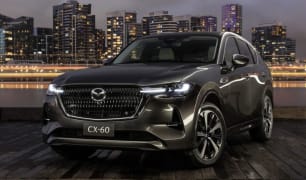Finding a comfortable driving position is easy in the EX5 Inspire with the octagonal steering wheel tilting and telescoping through a broad range of motion. The seats are supportive and well-bolstered, too — not a given in this class.
While we wish the front passenger seat was height adjustable, the Inspire’s leg rest and ability to lie the seats fully flat while charging is appreciated. The massage function has six modes, three intensity levels and is remarkably powerful.
Between the EX5’s front seats is a floating centre console as gear selection is done via the right-hand stalk. It has two small cup holders on top, while under that is a generous, rubberised storage space perfect for handbags, cameras, or the like. It’s where the USB-A, USB-C and 12-volt socket are located for device charging.
There is a wireless charging pad that sits ahead of a large central storage box cooled by the air-conditioning. The Geely EX5’s door cards will easily accept a 600mL camping bottle.
Where the Geely EX5 falls down is the control layout. It is nice to have four physical switches beneath the touchscreen as shortcuts to switch the air-conditioning on or off, engage air recirculation and the front demister, but where’s the hazard light switch? It's on the ceiling.
Then there’s the large rotary dial which generally functions as a volume knob. Press it down and you can choose to have it adjust the temperature, fan speed, or — for some reason — one of several desktop backgrounds, including a computer-generated kitten playing with some wool. In this mode it also works as cursor for the multimedia screen, but never at any other time. Peculiar.
The convoluted menu structure has a strange control hierarchy. There's a shortcut target for the rear fog light, for example, yet to disable the lane-keep assist or adjust the regenerative braking power you need to jump through at least three sub-menus. And some of the text in the Geely EX5’s digital driver’s display is so small it’s almost illegible.
Then there are the typos and grammatical errors that should have been an easy pre-launch fix. A few include: ‘Distractive. Drive carefully’, ‘Keep safety distance’, ‘Driver is facial detection is missing’ and, a personal favourite: ‘The current battery is low, whether to enable super battery life?’ None of this inspires much confidence. At least the EX5’s processor is responsive for smooth tapping between the many menus.
The Geely EX5’s 1000-watt 16-speaker sound system is punchy and has presets – borrowed from Volvo and Polestar — which promise to emulate the sound quality of a recording studio, concert hall and other locations. Gimmicky in practice, plus, with the volume over 30 per cent, the EX5’s sound quality is disappointingly muddy.
Connectivity promises to be strong in the EX5 but the cars we drove were not fitted with 4G sims for live navigation, app downloads and remote smartphone control. Apple CarPlay will be added via a software update in July and Android Auto before the end of the year, says Geely.
The Geely EX5’s back seat is very generous, at 188cm tall I had plenty of leg room, respectable toe room and excellent head room even underneath the standard panoramic sunroof. The floor is totally flat and, rarely, the middle seat is usable for adults.
Two more USB chargers can be found along with air vents, door pockets and a fold-down central armrest. There’s even a hidden sliding draw for storing valuables out of sight.
The Geely EX5 has ISOFIX child seat connectors on both outboard seats and three top tether anchors on its 40/60 split-fold backrest.
The EX5 Inspire has a standard power tailgate which opens up to a total of 410 litres of boot space. If it looks a little shallow in pictures, that’s because the total space accounts for the large under-floor area (108L on its own) where Geely skipped a spare tyre.
There is one LED boot light, two shopping bag hooks and a wet storage area off to the side but, curiously, no parcel shelf.

